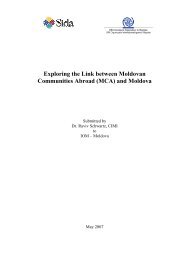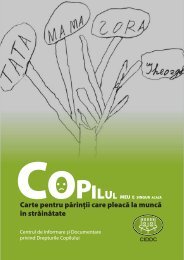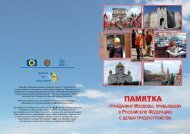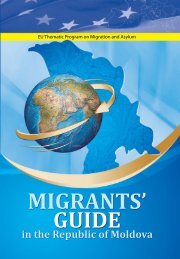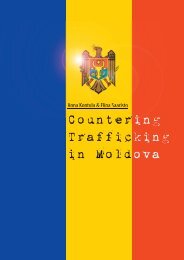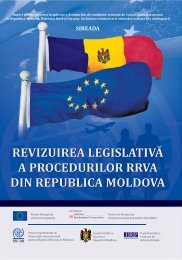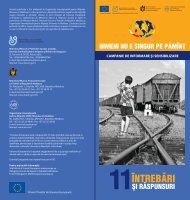Trafficking in Human Beings in Southeastern Europe - Iom
Trafficking in Human Beings in Southeastern Europe - Iom
Trafficking in Human Beings in Southeastern Europe - Iom
- No tags were found...
You also want an ePaper? Increase the reach of your titles
YUMPU automatically turns print PDFs into web optimized ePapers that Google loves.
<strong>Traffick<strong>in</strong>g</strong> <strong>in</strong> <strong>Human</strong> Be<strong>in</strong>gs<strong>in</strong> <strong>Southeastern</strong> <strong>Europe</strong>and children to traffick<strong>in</strong>g, <strong>in</strong>clud<strong>in</strong>g poverty, discrim<strong>in</strong>ation, <strong>in</strong>equality anddemand for the services of trafficked women and children.Summary andRecommendationsUntil now, all campaigns for prevention and rais<strong>in</strong>g awareness were organisedand run by the local NGOs and <strong>in</strong>ternational organisations with very limited<strong>in</strong>volvement of governmental <strong>in</strong>stitutions. Campaigns were mostly focused onrais<strong>in</strong>g the awareness of the general public and of particular groups, <strong>in</strong>clud<strong>in</strong>gpotential victims, politicians, journalists, youth, law enforcement agencies,judiciary, etc. The prevention element was limited to warn<strong>in</strong>gs about the dangersof migration addressed to high-risk groups, and to creat<strong>in</strong>g anti-migratorylaws, which were more part of state policies on migration.The first <strong>in</strong>formation campaigns were organised by NGOs. The best campaignsfollowed the model developed by La Strada for their campaigns organised <strong>in</strong>Central <strong>Europe</strong>. La Strada developed several rules, which are still used <strong>in</strong> alltheir campaigns, aimed at high risk groups and potential victims:• the well be<strong>in</strong>g of the trafficked women should be at the centre of allactivities;• the women should be provided with <strong>in</strong>formation which allows them tomake <strong>in</strong>formed decisions;• the women should be <strong>in</strong>formed about migration opportunities andrisks, about the legal situation <strong>in</strong> the countries of dest<strong>in</strong>ation andabout the assistance and support available.However, there is not much <strong>in</strong>formation about the results of the campaigns toraise awareness or their impact. To evaluate their campaigns, IOM, for<strong>in</strong>stance, is us<strong>in</strong>g as a measure of success the number of phone calls to theanti-traffick<strong>in</strong>g hotl<strong>in</strong>es, or the number of persons seek<strong>in</strong>g assistance. Usuallythe numbers go up dur<strong>in</strong>g, or directly after, such campaigns, only to decl<strong>in</strong>eaga<strong>in</strong> shortly, show<strong>in</strong>g that the campaigns achieve their goal but the resultsare not long last<strong>in</strong>g.Another evaluation tool is a public op<strong>in</strong>ion poll organised before and after thecampaign, to show the <strong>in</strong>crease <strong>in</strong> awareness of the issue among the generalpopulation. However, <strong>in</strong> the countries where traffick<strong>in</strong>g became an issue sometime ago, the general awareness is high, and majority of people declare theirknowledge of the issue. It is unknown exactly what the public know, as veryoften, declared knowledge means scandalous <strong>in</strong>formation about foreign prostituteswork<strong>in</strong>g with<strong>in</strong> the country or migrat<strong>in</strong>g for work abroad. There is aneed for more <strong>in</strong>formation about the nature of the crimes of traffick<strong>in</strong>g <strong>in</strong>human be<strong>in</strong>gs, as well as to view trafficked persons as victims of crime.The impact of the campaigns for high-risk groups and potential victims is notknown. There is, therefore, a need for more <strong>in</strong>formation about the impact ofthe campaigns organised to date, to <strong>in</strong>clude research and evaluation as wellas collect<strong>in</strong>g <strong>in</strong>formation from trafficked persons about their assessment ofthe campaigns, and suggestions for prevention tools and peer educationmethods.Governments’ <strong>in</strong>volvement <strong>in</strong> campaigns for prevention and rais<strong>in</strong>g awarenessto date has been limited. Governments have tended to approve and sometimessupport NGOs and IOM programmes, rather than come with their own<strong>in</strong>itiatives. Long-term prevention measures <strong>in</strong>clud<strong>in</strong>g anti-discrim<strong>in</strong>atorymeasures, job opportunities for women, legal migration projects aimed atwomen, the rais<strong>in</strong>g of awareness and programmes aga<strong>in</strong>st violence aga<strong>in</strong>stwomen, are planned under the NPAs, but not yet implemented.159



